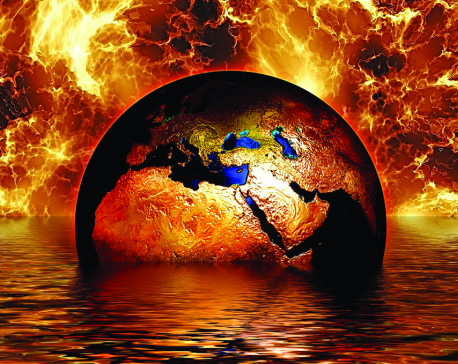
OR
Opinion
Climate Change Scenario of Nepal
Published On: October 28, 2021 07:00 AM NPT By: Roshan Kumar Chhetri | @@Roshanc60167671
_20211027160750.jpg)

Roshan Kumar Chhetri
The author is a Mechanical Engineer, currently working as a Renewable Energy Officer at WindPower Nepal Pvt Ltd.news@myrepublica.com
More from Author
In Nepal, the majority of people affected by climate change are women who are disproportionality at risk, whether from floods, in which more women drown than men or through working in agriculture, where women carry out most of the additional labor required to cope with the lack of water and the new diseases that climate change will bring.
Mosquito, an insect which was never expected in Namche Bazaar due to its cold climatic condition, has been spotted there to a noticeable extent in recent years. This is a distressing example of species shift resulting due to climate change. Although Nepal is one of the lowest per capita carbon emitters (0.43 metric tons), it is one of the most climate-vulnerable countries in the world and has already experienced changes in temperature and precipitation at a faster rate than the global average. The Paris Accord of 2015 aimed to limit the average temperature rise from 1.5 to 2 degrees Celsius warmer compared to the pre-industrial level but the recent Intergovernmental Panel on Climate Change (IPCC) report has clearly stated that the global temperature will surpass the target of 1.5 degree Celsius or even 2 in about two decades resulting in a catastrophic situation. However, efforts have been made by member countries of UNFCCC with their pledge to work on the Nationally Determined Contributions (NDCs) that would set their own targets for reducing greenhouse gas emission by promoting clean energy and cutting coal and petroleum use.
There are various policy interventions for climate change in Nepal where climate change issues fall under the jurisdiction of the Ministry of Forest and Environment. Nepal formulated a Climate Change Policy in 2019 which is the centerpiece of Nepal’s response to climate change with several related past efforts complementing it, including the Nepal Adaptation Program of Action (NAPA) focused on addressing the immediate and urgent adaptation needs. To implement NAPA in municipalities and villages, Nepal has also developed Local Adaptation Plans of Action (LAPAs) and Community Adaptation Plans of Action (CAPAs). Nepal has also presented its second NDC report to UNFCCC outlining its ambitious targets for the next decade (upto 2030) to build climate-resilient societies with pragmatic adaptation and mitigation measures to fight against climate change.
Nepal’s vulnerability could be elevated by the fact of the country’s fragile ecosystem, uneven topography, low GDP, and high dependency on hydroelectricity and agriculture. Nepal’s changing climate has been impacting the country’s main ecosystems like forests, grasslands, rangelands, wetlands, mountains, and agro-ecosystems. Effects have been observed as rainy days are decreasing but high-intensity rainfall events are spiking, resulting in an increase in water-induced disasters like floods, flash floods, debris flows, landslides, and slope failures. On the other hand, the possible threat of Glacier Lake Outburst Floods (GLOFs) is also increasing in Nepal as 26 out of 2,315 glacial lakes are potentially dangerous for GLOFs, wreaking havoc to downstream communities and the hydropower projects. The increasing temperature and rainfall variability have resulted in tree-line shifts along with the species shift which could cause the extinction of endangered flora and fauna. An increase in the intensity and frequency of droughts can lead to forest fires and in 2021 alone 60 places across 22 districts of Nepal were impacted by forest fires which is 15 times the number of fires in 2020. Due to increasing drought, wetlands in Terai have been depleted, resulting in devastation of fish and aquatic plants. The agricultural sector has been also affected by climate change as the most productive agricultural areas are in the floodplains of Terai, which are vulnerable to riverbank cutting and floods. In the western Terai plains, due to the late arrival of monsoon and frequent drought, rice yields have declined, threatening food security. An increase in pests and diseases due to increased temperature has also affected crop and livestock production. Health risks from climate change range from heat stress to a rise in waterborne and vector-borne diseases. Waterborne infectious diseases such as cholera had an outbreak from increased temperature and diversified rain patterns. Increased incidence of vector-borne diseases such as malaria, kala-azar, Japanese encephalitis in Nepal has been especially linked to rainfall.
In Nepal, the majority of people affected by climate change are women who are disproportionality at risk, whether from floods, in which more women drown than men or through working in agriculture, where women carry out most of the additional labor required to cope with the lack of water and the new diseases that climate change will bring.
To combat climate change in Nepal, pragmatic policies and actions are going to be of utmost importance. Use of renewable energy technologies in different sectors should be promoted. It’s high time the government promoted zero emission electric vehicles and electric railways with competent charging stations all over Nepal. Moreover, solutions should be explored for clean cooking solutions by the use of electric stoves, improved stoves and biogas technology. The government should develop a provision for the use of environmentally-friendly solar water pumps to irrigate the arable land. Likewise, ponds should be built in villages in order to harvest rainwater which would later be used for different purposes. There should be a provision for identifying and conserving the sensitive watersheds. To increase the carbon content of the soil, the use of organic fertilizers should be fostered along with discouraging the use of chemical fertilizers. Similarly, the local government can initiate programs to build environmentally-friendly model agricultural villages, climate smart villages and carbon neutral tourist destinations. Although about 45% of land is covered with forest in Nepal, it can still be increased by the plantation program in barren land of urban areas and by promoting community forests. There should be a provision for appropriate technologies and training to control as well as manage invasive species like Banmara and forest fire. Unplanned development works have always become a bottleneck for the environment, so detailed environmental studies should be conducted before carrying out any construction and development projects. Carbon emission from industries should be controlled and the “Polluters Pay” mechanism should be effectively implemented. A national level master plan should be made for waste management and sewage management. The government should focus on disaster risk reduction plans along with the deployment of hydro-meteorological stations in climate hazardous areas so that the early warning or messages could be delivered to the climate vulnerable societies and groups.
In the UN climate change summit i.e. COP26 which will be held in Glasgow in November 2021, world leaders have to commit to drastic reductions in greenhouse gas emissions. This could be done by emphasizing the wealthy countries which are far off track for delivering the climate finance (about $ 100 billion per year) they committed to deliver to the developing and vulnerable countries over a decade ago. The delegates should ensure that Nepal’s voice is heard in the inclusive climate negotiations at the upcoming COP26 which matters not only for the people of Nepal but also for the continent of Asia.
(The author is a Mechanical Engineer, currently working as a Renewable Energy Officer at WindPower Nepal Pvt Ltd.)
You May Like This

Nepal must be ready for Kunming and Glasgow
Two upcoming key global summits should be adequately prepared with a strong inclusive public engagement at home and smart diplomacy... Read More...

Nepal’s climate action
That we have to face the adverse impacts of climate change is certain. Question for Nepal is whether we are... Read More...

The pain of going around
Nepal aviation has been subjected to EASA’s blacklisting since December 2013 because many European lives were lost in domestic sectors... Read More...







Just In
- NRB to provide collateral-free loans to foreign employment seekers
- NEB to publish Grade 12 results next week
- Body handover begins; Relatives remain dissatisfied with insurance, compensation amount
- NC defers its plan to join Koshi govt
- NRB to review microfinance loan interest rate
- 134 dead in floods and landslides since onset of monsoon this year
- Mahakali Irrigation Project sees only 22 percent physical progress in 18 years
- Singapore now holds world's most powerful passport; Nepal stays at 98th











Leave A Comment